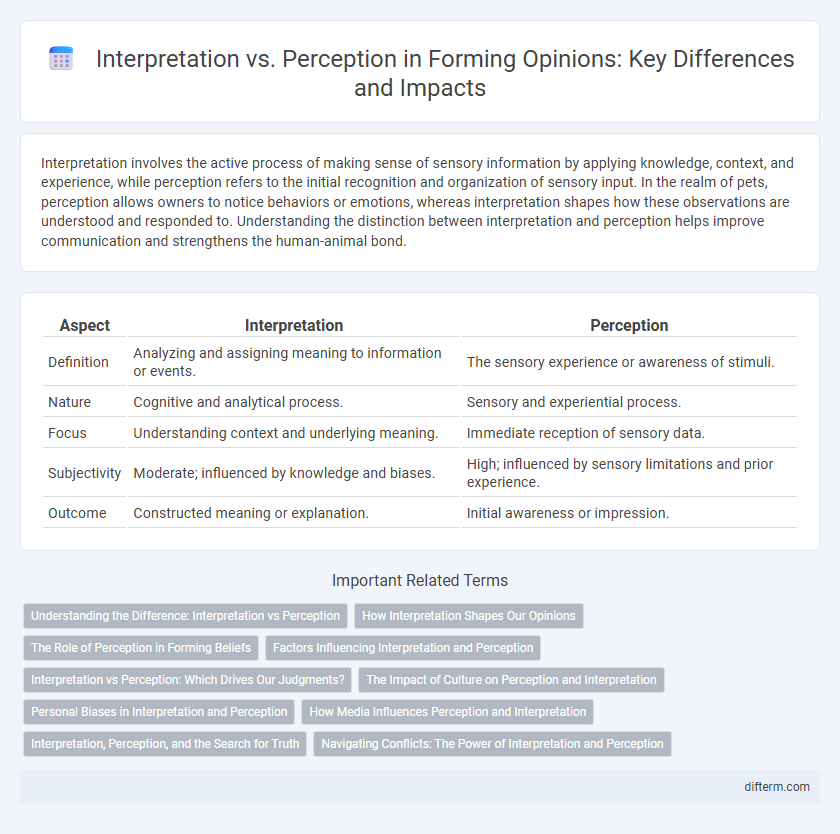Interpretation involves the active process of making sense of sensory information by applying knowledge, context, and experience, while perception refers to the initial recognition and organization of sensory input. In the realm of pets, perception allows owners to notice behaviors or emotions, whereas interpretation shapes how these observations are understood and responded to. Understanding the distinction between interpretation and perception helps improve communication and strengthens the human-animal bond.
Table of Comparison
| Aspect | Interpretation | Perception |
|---|---|---|
| Definition | Analyzing and assigning meaning to information or events. | The sensory experience or awareness of stimuli. |
| Nature | Cognitive and analytical process. | Sensory and experiential process. |
| Focus | Understanding context and underlying meaning. | Immediate reception of sensory data. |
| Subjectivity | Moderate; influenced by knowledge and biases. | High; influenced by sensory limitations and prior experience. |
| Outcome | Constructed meaning or explanation. | Initial awareness or impression. |
Understanding the Difference: Interpretation vs Perception
Interpretation involves analyzing and assigning meaning to information based on personal knowledge, context, and experience, whereas perception is the initial sensory experience or awareness of stimuli. Understanding the difference between interpretation and perception is crucial for effective communication, as perception shapes how information is received, while interpretation determines how it is understood and responded to. This distinction impacts decision-making, problem-solving, and emotional responses in various social and cognitive contexts.
How Interpretation Shapes Our Opinions
Interpretation deeply influences our opinions by filtering sensory information through personal experiences, cultural background, and cognitive biases, which transforms raw perception into meaningful insights. This process dictates how individuals assign value and significance to the information they receive, ultimately shaping their viewpoints and judgments. Understanding the role of interpretation reveals that opinions are constructed rather than simply observed, highlighting the subjective nature of human understanding.
The Role of Perception in Forming Beliefs
Perception plays a critical role in forming beliefs by filtering sensory information through individual biases and experiences, shaping how reality is understood. The brain's interpretation of perceptions often leads to subjective truths rather than objective facts, influencing attitudes and decision-making. Recognizing the malleability of perception helps in questioning the validity of deeply held beliefs and encourages openness to alternate viewpoints.
Factors Influencing Interpretation and Perception
Interpretation and perception are shaped by a variety of cognitive, emotional, and cultural factors that influence how individuals process sensory information and assign meaning. Personal experiences, beliefs, and social context play crucial roles in determining the subjective nature of interpretation, while perception is more directly affected by attention, sensory abilities, and environmental stimuli. Understanding these factors helps clarify why people often perceive and interpret the same information differently, highlighting the complexity of human cognition and communication.
Interpretation vs Perception: Which Drives Our Judgments?
Interpretation shapes our judgments by actively assigning meaning to perceptions, transforming raw sensory data into contextual understanding. Perception provides the foundational input from the environment, but interpretation filters and organizes this information based on prior knowledge, experiences, and biases. The interplay between interpretation and perception is crucial, yet interpretation ultimately drives the conclusions and decisions we make about the world.
The Impact of Culture on Perception and Interpretation
Culture shapes perception by influencing the sensory and cognitive processes through which individuals receive and organize information. Interpretation varies significantly across cultural contexts because cultural norms, values, and experiences provide distinct frameworks for making sense of those perceptions. Understanding this dynamic allows for more accurate communication and reduces misunderstandings in cross-cultural interactions.
Personal Biases in Interpretation and Perception
Personal biases significantly shape interpretation and perception, influencing how individuals process information and form judgments. Cognitive biases like confirmation bias and selective perception lead to subjective realities where facts are filtered through personal beliefs and experiences. Recognizing these biases is essential to achieving more accurate and balanced understanding in analysis and decision-making.
How Media Influences Perception and Interpretation
Media shapes perception by selectively highlighting certain events and framing narratives that influence audience interpretation. Visual and linguistic cues within media content guide viewers' understanding, often reinforcing biases and stereotypes. The repetition and emotional appeal of media messages solidify specific worldviews, altering collective and individual meaning-making processes.
Interpretation, Perception, and the Search for Truth
Interpretation shapes our understanding of sensory data by assigning meaning, while perception is the immediate experience of stimuli. The search for truth hinges on refining interpretation to align subjective perception with objective reality. Distinguishing between perception and interpretation is crucial for critical thinking and uncovering deeper truths.
Navigating Conflicts: The Power of Interpretation and Perception
Navigating conflicts hinges on understanding the distinction between interpretation and perception, as interpretation shapes the meaning we assign to events, while perception influences how we initially experience them. Recognizing that interpretations are subjective and open to bias allows individuals to approach disagreements with empathy and flexibility, reducing misunderstandings. This awareness fosters constructive dialogue and resolution by prioritizing clarity and emotional intelligence over assumptions.
interpretation vs perception Infographic

 difterm.com
difterm.com